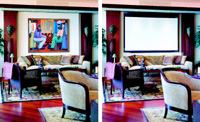Lawmakers and television-industry leaders are still squabbling over the turn-off date for analog TV that will officially usher in the high-definition age, but most custom electronics installation specialists are designing A/V systems as if the HDTV transition was yesterday’s news.
As recently as March at the annual HDTV Summit in Washington, D.C., members of Congress proposed turning off the switch on analog TV at the end of this year. That’s even ahead of the late-2006 time-frame originally proposed in the Balanced Budget Act of 1997, which would allow the Federal Communications Commission to auction off the analog TV spectrum and stuff the proceeds into government coffers.
But with household penetration of digital TV at just 16 percent, and the cable, broadcast, and consumer electronics industries at odds over transition procedures and regulations, it could still be several years before TV broadcasts are exclusively digital.
A major hurdle involves how many local broadcast channels cable providers will have to deliver to their subscribers. In the analog world, cable providers are required to carry local broadcast channels in their basic TV package. In the digital world, four or five digital channels can fit in the space required by one high-definition channel, and broadcasters expect to use those multiple streams for commercial gain during non-prime-time programming. Cable companies argue that they shouldn’t have to carry multiple streams of broadcasters’ channels at the expense of their own premium channels.
Retail pricing is more attractive than it has ever been. Consumers can snag a 52-inch rear-projection HDTV monitor for $1,300, while 60-inch plasma TVs have dived to $6,000 or less. Consumers looking for a big-screen TV would be hard-pressed to find an analog model today. For the first time, in 2005 the number of home-theater-grade digital TVs sold at retail is expected to exceed sales of analog TVs. In short, the cutoff date for analog TV may not be set in stone, but consumers are transitioning on their own terms. And luxury-home owners are leading the way.
“I can’t think of the last TV over 30 inches that we’ve sold that wasn’t high-definition,” says Robert Ruderman, president and owner of the installation firm Harmony Home Systems in Ft. Lauderdale, Fla. Ruderman’s upscale clients do whatever is required to pull in the pristine signals. That includes locating spots for satellite receivers and cable boxes and even making space for unsightly ’50s-era antennas to catch over-the-air broadcasts.
“A lot of builders in our area are making sure wiring is in place,” Ruderman says, “but we always tell them to make sure there’s enough. The cost of running additional cable in the building stage is so negligible that it doesn’t make sense not to do a lot of it,” he says.



